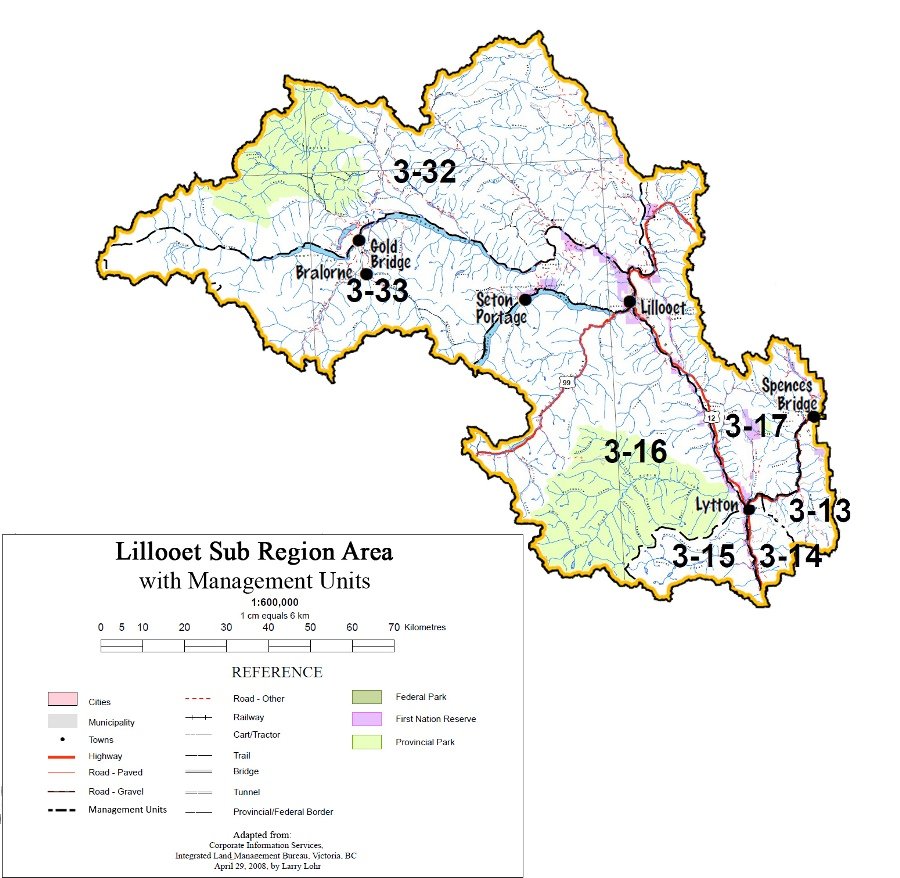Main Sections
Biodiversity in Forested Areas
The conservation of biodiversity depends on providing a range of forest conditions at a variety of scales:
- at the regional scale, through protected areas (see Section 4.5);
- at the watershed or landscape scale, through a mosaic of forests with differing structures and ages (seral stages); and
- at the cutblock or stand scale, by retaining important ecosystem features such as wildlife tree patches and coarse woody debris.
At the landscape or watershed level, the desired seral stage distribution depends on the types of ecosystems present and the biodiversity emphasis that is assigned to the landscape (see map).
Biodiversity emphasis options are based on the presence of species at risk, rare forest ecosystems, and the history of industrial development.
An important way of conserving biodiversity is to identify and maintain old growth management areas. These areas provide food and shelter for species that depend on old forests.
Issues:
- Current policy on old growth management will leave out some important forest types, but protecting these forests could reduce the amount of harvestable timber.
- Biodiversity and native species can be lost by forest harvesting practices that do not resemble natural disturbance patterns (e.g., fire, pests, and landslides).
- The loss of important ecosystem features at the stand scale (e.g., coarse woody debris and wildlife trees) can reduce species diversity.
Goals:
- Forest and grassland biodiversity is sustained at all scales over space and time
Forest Biodiversity and Grassland Ecosystems
| Objectives | Management Direction/Strategies | Measures of Success/Targets | Intent |
|---|---|---|---|
| Landscape Level Objectives | |||
| 1. Provide for landscape level biodiversity within landscape units using the assigned biodiversity emphasis options (see map) | 1.1 Achieve old seral targets within biodiversity emphasis options consistent with current policies (e.g., Landscape Unit Planning Guide) | Provincial and forest district policies achieved | |
| 2. Select old growth management areas to meet old targets and ecosystem representation while maximizing benefits for multiple resources | 2.1 Use ecological and biological criteria when selecting old growth management areas. When ecological and biological values are equal between candidate old growth management areas, consider social and economic criteria developed through communications with First Nations and other communities. | Old growth management areas selected to meet targets and ecological representation by 2006 | Incorporate other old forest attributes or wildlife values associated with old and mature forests to identify alternative old growth management areas |
2.2 Use the following old growth management area placement and recruitment priorities in forested lands, in order to minimize timber harvesting land base impacts:
|
|||
| 2.3 Incorporate information about First Nations ethno-botanical / zoological resources and traditional land use and practices in old growth management area placement and recruitment decisions | |||
| 2.4 In the Yalakom Local Resource Use Plan area, the mapped ‘developed climax sites’ should be considered as old growth management area candidates | |||
| 2.5 In the Cayoosh, Van Horlick, Blowdown and Gott Creek watersheds, priority for old growth management area placement should be areas with old growth dependent species and rare coastal western hemlock stands | |||
| 2.6 Where practical, avoid placing old growth management areas where they would impact mineral values, in particular known deposits and/or tenures | |||
| 2.7 Evaluate the initial old growth management area selection to determine if the identified oldgrowth management areas are a representative sample of each variant. Based on this information, MSRM may revise the initial old growth management area selection to improve representation | |||
| 2.8 Provide opportunities for First Nations, stakeholders and agencies to comment on the recommended old growth management areas | |||
| 3. Manage cut and leave patterns, notably in larger cutblocks, to mimic the scale and patterns of natural disturbances so that known and predicted wildlife movement corridors retain appropriate cover over rotations and habitat fragmentation is minimized | 3.1 During the basic biodiversity phase of landscape unit planning, identify opportunities for larger blocks and encourage operational policies, procedures and practices | Harvest patterns consistent with natural disturbance patterns Cut and leave patterns allow for wildlife movement or connectivity along corridors Habitat continuity | |
| 3.2 Where there is a shortfall of larger sized patches within a landscape unit, aggregate existing cutblocks | |||
| 3.3 Use the appropriate patch size distribution tables in the Landscape Unit Planning Guide | |||
| Stand Level Objectives | |||
| 1. Manage timber harvesting to maintain forest biodiversity at the stand level by retaining wildlife tree patches in harvested areas, historic distribution and representation of tree species and coarse woody debris | 1.1 Avoid extensive conversions from climax to early successional species, or deciduous to conifer | Wildlife tree patches left in harvested areas Distribution and representation patterns of tree species | |
| 1.2 Establish wildlife tree patches as directed in the Landscape Unit Planning Guide | |||
